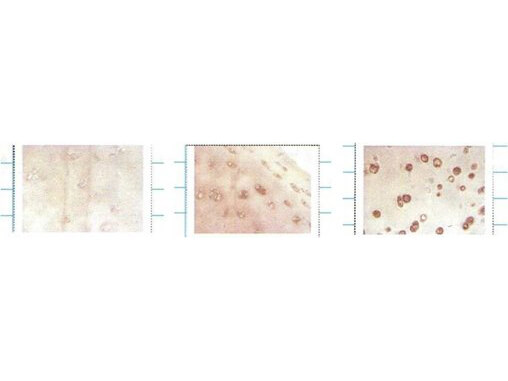Datasheet is currently unavailable. Try again or CONTACT US
SOD3 Antibody
Mouse Monoclonal 4GG11G6 IgG1 kappa
200-301-F24
100 µg
Liquid (sterile filtered)
WB, IHC, IF
Human, Mouse, Rat
Mouse
Shipping info:
$50.00 to US & $70.00 to Canada for most products. Final costs are calculated at checkout.
Product Details
Anti-SOD3 (MOUSE) Monoclonal Antibody - 200-301-F24
EC-SOD, MGC20077, EC 1.15.1.1, SOD3, Extracellular superoxide dismutase [Cu-Zn]
Mouse
Monoclonal
IgG1
Target Details
SOD3 - View All SOD3 Products
Human, Mouse, Rat
Other
SOD3 Antibody was produced in mice by repeated immunizations with human SOD3 purified from aortas.
Anti-SOD3 Antibody was purified by Protein G chromatography. A BLAST analysis was used to suggest cross-reactivity with SOD3 from human, rat, and mouse based on 100% homology with the immunizing sequence. Cross-reactivity with SOD3 from other sources has not been determined.
P08294 - UniProtKB
NP_003093.2 - NCBI Protein
Application Details
IF, IHC, WB
Anti-SOD3 Antibody has been tested by WB, IHC and IF and is recommended for use in ELISA. Expect a band approximately ~35kDa in specific lysates. Specific conditions for reactivity should be optimized by the end user.
Formulation
1mg/mL by UV absorbance at 280 nm
0.02 M Potassium Phosphate, 0.15 M Sodium Chloride, pH 7.2
50% (v/v) Glycerol
Shipping & Handling
Dry Ice
Store vial at -20° C prior to opening. Aliquot contents and freeze at -20° C or below for extended storage. Avoid cycles of freezing and thawing. Centrifuge product if not completely clear after standing at room temperature. This product is stable for several weeks at 4° C as an undiluted liquid. Dilute only prior to immediate use.
Expiration date is one (1) year from date of receipt.
Superoxide dismutase (SOD) is an endogenously produced intracellular enzyme present in almost every cell in the body. It works by catalyzing the dismutation of the superoxide radical O2ˉ to O2 and H2O2, which are then metabolized to H2O and O2 by catalase and glutathione peroxidase. In general, SODs play a major role in antioxidant defense mechanisms. There are three types of SOD in mammalian cells. One form (SOD1) contains Cu and Zn ions as a homodimer and exists in the cytoplasm. The two subunits of 16 kDa each are linked by two cysteines forming an intra-subunit disulphide bridge. The second form (SOD2) is a manganese containing enzyme and resides in the mitochondrial matrix. It is a homotetramer of 80 kDa. The third form (SOD3 or EC-SOD) is like SOD1 in that it contains Cu and Zn ions, however it is distinct in that it is a homotetramer, with a mass of 30 kDA and it exists only in the extra-cellular space. SOD3 can also be distinguished by its heparin-binding capacity.
This product is for research use only and is not intended for therapeutic or diagnostic applications. Please contact a technical service representative for more information. All products of animal origin manufactured by Rockland Immunochemicals are derived from starting materials of North American origin. Collection was performed in United States Department of Agriculture (USDA) inspected facilities and all materials have been inspected and certified to be free of disease and suitable for exportation. All properties listed are typical characteristics and are not specifications. All suggestions and data are offered in good faith but without guarantee as conditions and methods of use of our products are beyond our control. All claims must be made within 30 days following the date of delivery. The prospective user must determine the suitability of our materials before adopting them on a commercial scale. Suggested uses of our products are not recommendations to use our products in violation of any patent or as a license under any patent of Rockland Immunochemicals, Inc. If you require a commercial license to use this material and do not have one, then return this material, unopened to: Rockland Inc., P.O. BOX 5199, Limerick, Pennsylvania, USA.

